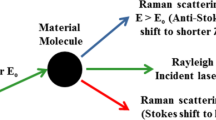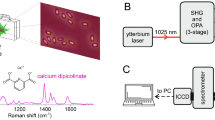Abstract
In general, any standoff sensor for the effective detection of explosives must meet two basic requirements: first, a capacity to detect the response generated from only a small amount of material located at a distance of several meters (high sensitivity) and second, the ability to provide easily distinguishable responses for different materials (high specificity). Raman spectroscopy and laser-induced breakdown spectroscopy (LIBS) are two analytical techniques which share similar instrumentation and, at the same time, generate complementary data. These factors have been taken into account recently for the design of sensors used in the detection of explosives. Similarly, research on the proper integration of both techniques has been around for a while. A priori, the different operational conditions required by the two techniques oblige the acquisition of the response for each sensor through sequential analysis, previously necessary to define the proper hierarchy of actuation. However, such an approach does not guarantee that Raman and LIBS responses obtained may relate to each other. Nonetheless, the possible advantages arising from the integration of the molecular and elemental spectroscopic information come with an obvious underlying requirement, simultaneous data acquisition. In the present paper, strong and weak points of Raman spectroscopy and LIBS for solving explosives detection problems, in terms of selectivity, sensitivity, and throughput, are critically examined, discussed, and compared for assessing the ensuing options on the fusion of the responses of both sensing technologies.





Similar content being viewed by others
References
Wallin S, Pettersson A, Ostmark H, Hobro A (2009) Laser-based standoff detection of explosives: a critical review. Anal Bioanal Chem 395:259–274
Moore DS (2007) Recent advances in trace explosives detection instrumentation. Sens Imaging 8:9–38
Miziolek A, De Lucia FC, Munson CA, Gottfried JL (2008) Recent progress in LIBS-based technologies for security applications. Laser Applications to Chemical, Security and Environmental Analysis. OSA (Optical Society of America) Technical Digest (CD), paper LThC1.
Pacheco-Londoño LC, Ortiz-Rivera W, Primera-Pedrozo OM, Hernández-Rivera SP (2009) Vibrational spectroscopy standoff detection of explosives. Anal Bioanal Chem 395:323–335
Wiens RC, Sharma SK, Thompson J, Misra AK, Lucey PG (2005) Joint analyses by laser-induced breakdown spectroscopy (LIBS) and Raman spectroscopy at stand-off distances. Spectrochim Acta A 61:2324–2334
Giakoumaki A, Osticioli I, Anglos D (2006) Spectroscopic analysis using a hybrid LIBS–Raman system. Appl Phys A 83:537–541
Courrèges-Lacoste GB, Ahlers B, Rull Pérez F (2007) Combined Raman spectrometer/laser-induced breakdown spectrometer for the next ESA mission to Mars. Spectrochim Acta A 68:1023–1028
Escudero-Sanz I, Ahlers B, Courrèges-Lacoste GB (2008) Optical design of a combined Raman–laser-induced-breakdown-spectroscopy instrument for the European Space Agency ExoMars Mission. Opt Eng 47:033001
Sharma SK, Misra AK, Lucey PG, Wiens RC, Clegg SM (2007) Combined remote LIBS and Raman spectroscopy at 8.6 m of sulfur-containing minerals, and minerals coated with hematite or covered with basaltic dust. Spectrochim Acta A 68:1036–1045
Sharma SK, Misra AK, Lucey PG, Lentz RCF (2009) A combined remote Raman and LIBS instrument for characterizing minerals with 532 nm laser excitation. Spectrochim Acta A 73:468–476
Osticioli I, Mendes NFC, Porcinai S, Cagnini A, Castellucci E (2009) Spectroscopic analysis of works of art using a single LIBS and pulsed Raman setup. Anal Bioanal Chem 394:1033–1041
Carter JC, Angel SM, Lawrence-Snyder M, Scaffidi J, Whipple RE, Reynolds JG (2005) Standoff detection of high explosive materials at 50 meters in ambient light conditions using a small Raman instrument. Appl Spectrosc 59:769–775
Moros J, Lorenzo JA, Lucena P, Miguel-Tobaria L, Laserna JJ (2010) Simultaneous Raman spectroscopy–laser-induced breakdown spectroscopy for instant standoff analysis of explosives using a mobile integrated sensor platform. Anal Chem 82:1389–1400
Haley L, Thekkadath G (1998) Laser detection of explosive residues. US Patent 5760898
López-Moreno C, Palanco S, Laserna JJ, Lucia D, Jr F, Miziolek AW, Rose J, Walters RA, Whitehouse A (2006) Test of a stand-off laser-induced breakdown spectroscopy sensor for the detection of explosive residues on solid surfaces. J Anal At Spectrom 21:55–60
González R, Lucena P, Tobaria LM, Laserna JJ (2009) Standoff LIBS detection of explosive residues behind a barrier. J Anal At Spectrom 24:1123–1126
Laserna JJ, Fernández-Reyes R, González R, Tobaria L, Lucena P (2009) Study on the effect of beam propagation through atmospheric turbulence on standoff nanosecond. Optic Express 17:10265–10276
Ferrero A, Laserna JJ (2008) A theoretical study of atmospheric propagation of laser and return light for stand-off laser induced breakdown spectroscopy purposes. Spectrochim Acta B 63:305–311
Gaft M, Nagli L (2008) UV gated Raman spectroscopy for standoff detection of explosives. Opt Mater 30:1739–1746
Pettersson A, Johansson I, Wallin S, Nordberg M, Östmark H (2009) Near real-time standoff detection of explosives in a realistic outdoor environment at 55 m distance. Propellants Explos Pyrotech 34:297–306
De Lucia Jr FC, Gottfried JL, Munson CA, Miziolek AW (2007) Double pulse laser-induced breakdown spectroscopy of explosives: initial study towards improved discrimination. Spectrochim Acta B 62:1399–1404
Gottfried JL, De Lucia Jr FC, Munson CA, Miziolek AW (2007) Double-pulse standoff laser-induced breakdown spectroscopy for versatile hazardous materials detection. Spectrochim Acta B 62:1405–1411
Waterbury RD, Pal A, Killinger DK, Rose J, Dottery EL, Ontai G (2008) Standoff LIBS measurements of energetic materials using a 266 nm excitation laser. Proc SPIE 6954:695409–695409-5
De Lucia Jr FC, Gottfried JL, Munson CA, Miziolek AW (2008) Multivariate analysis of standoff laser-induced breakdown spectroscopy spectra for classification of explosive-containing residues. Appl Opt 47:G112–G121
Rai S, Rai AK, Thakur SN (2008) Identification of nitro-compounds with LIBS. Appl Phys B 91:645–650
Boumans PWJM, Vrakking JJAM (1987) Detection limit including selectivity as a criterion for line selection in trace analysis using inductively coupled plasma-atomic emission spectrometry (ICP-AES)—a tutorial treatment of a fundamental problem of AES. Spectrochim Acta B 42:819–840
James DW, Leong WH (1970) Structure of molten nitrates. Part 4.—Relative intensity study in Raman spectra. Trans Faraday Soc 66:1948–1954
Abdelli-Messaci S, Kerdja T, Bendib A, Malek S (2005) CN emission spectroscopy study of carbon plasma in nitrogen environment. Spectrochim Acta B 60:955–959
Baudelet M, Boueri M, Yu J, Mao SS, Piscitelli V, Mao X, Russo RE (2007) Time-resolved ultraviolet laser-induced breakdown spectroscopy for organic material analysis. Spectrochim Acta B 62:1329–1334
Sallé B, Mauchien P, Maurice S (2007) Laser-induced breakdown spectroscopy in open-path configuration for the analysis of distant objects. Spectrochim Acta B 62:739–768
Cabalín LM, González A, Ruiz J, Laserna JJ (2010) Assessment of statistical uncertainty in the quantitative analysis of solid samples in motion using laser-induced breakdown spectroscopy. Spectrochim Acta B 65:680–687
López-Moreno C, Palanco S, Laserna JJ (2007) Stand-off analysis of moving targets using laser-induced breakdown spectroscopy. J Anal At Spectrom 22:84–87
Acknowledgments
This research was supported by Project CTQ2007-60348 of the Spanish Ministerio de Ciencia e Innovación and by Excellence Research Project P07-FQM-03308 of the Secretaría General de Universidades, Investigación y Tecnología, Consejería de Innovación, Ciencia y Empresa de la Junta de Andalucía. The research leading to these results has received funding from the European Community’s Seventh Framework Program (FP7/2007-2013) under grant agreement no. 218037.
Author information
Authors and Affiliations
Corresponding author
Additional information
Published in the special issue Laser-Induced Breakdown Spectroscopy with Guest Editors Jagdish P. Singh, Jose Almirall, Mohamad Sabsabi, and Andrzej Miziolek.
Rights and permissions
About this article
Cite this article
Moros, J., Lorenzo, J.A. & Laserna, J.J. Standoff detection of explosives: critical comparison for ensuing options on Raman spectroscopy–LIBS sensor fusion. Anal Bioanal Chem 400, 3353–3365 (2011). https://doi.org/10.1007/s00216-011-4999-y
Received:
Revised:
Accepted:
Published:
Issue Date:
DOI: https://doi.org/10.1007/s00216-011-4999-y




